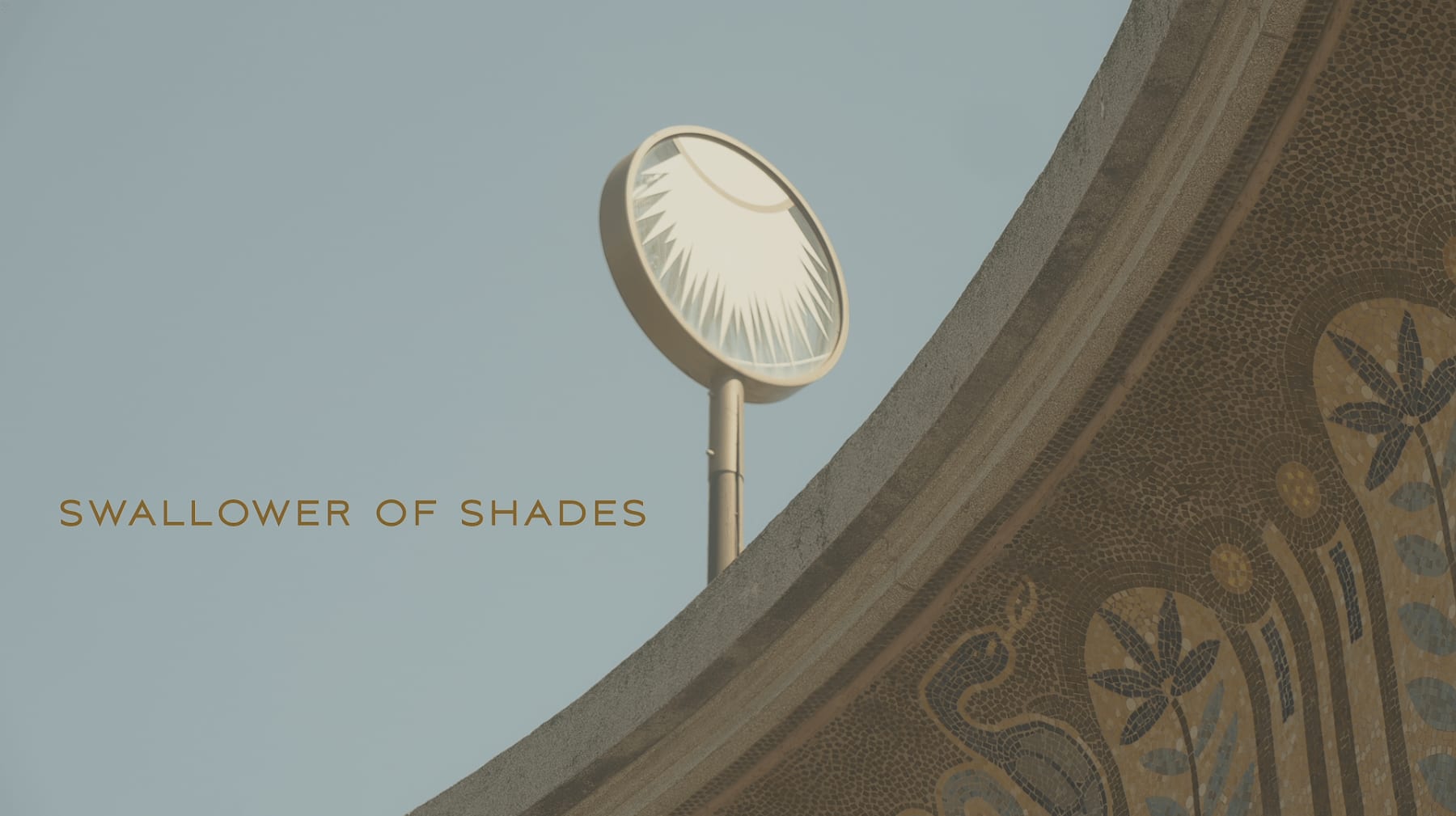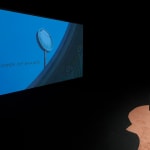Open a larger version of the following image in a popup:
 Photography by Darius Petrulaitis
Photography by Darius Petrulaitis
 Photography by Darius Petrulaitis
Photography by Darius Petrulaitis
Open a larger version of the following image in a popup:
 Photography by Darius Petrulaitis
Photography by Darius Petrulaitis
 Photography by Darius Petrulaitis
Photography by Darius Petrulaitis
Goda Palekaitė Lithuanian, b. 1987
In collaboration with Graham Kelly "Šešėlių rijikė" / "Swallower of Shades", 2023
video kūrinys / video
'32
Edition of 4 plus 2 artist's proofs
Further images
(lietuviškas aprašas apačioje) EN: This film is a poetic investigation into the phenomenon of Egyptomania, or the fetishization of Ancient Egyptian aesthetics and culture in the West. It is impossible...
(lietuviškas aprašas apačioje)
EN:
This film is a poetic investigation into the phenomenon of Egyptomania, or the fetishization of Ancient Egyptian aesthetics and culture in the West. It is impossible to determine when exactly this fascination began. As early as 10 BC, the Roman Emperor Augustus seized the first obelisks and transported them to Rome. Egyptomania took off in 1799 with the discovery of the Rosetta Stone by Napoleon’s soldiers and the subsequent deciphering of its hieroglyphics. During the nineteenth and twentieth centuries, Orientalism has been manifested in everything from science, politics, conspiracy theories, film, literature, music, architecture, fine art, and theatre to everyday objects.
Filmed at various locations in Paris and Brussels, the work centres around the reconstructed Art-Deco-style Louxor Cinema building while simultaneously guiding the viewer through images and spaces of replication, appropriation, and distortion: a display of 3D-printed duplicates of Ancient Egyptian artefacts, sequences of the violent destruction of monuments in the Hollywood Cinema, and a dog resembling Anubis, wandering aimlessly in a forest. The film’s text, written and narrated by Goda Palekaitė, alternates between her native Lithuanian and English, combining critical theory with a disembodied voice of a ghost lamenting over the loss of its identity through the displacement and perpetual reproduction.
LT:
Šis filmas – tai poetinis bandymas suprasti egiptomanijos, arba Senovės Egipto estetikos ir kultūros fetišizavimo Vakaruose, reiškinį. Neįmanoma nustatyti, kada tiksliai susiformavo šis – bene maniškas – susižavėjimas. Jau 10 m. pr. Kr. Romos imperatorius Augustas pasisavino pirmuosius obeliskus ir nugabeno juos į Romą. Egiptomanija išvešėjo nuo 1799 m., Napoleono kariams atradus Rozetos akmenį ir Jean-François Champollion pirmą kartą iššifravus egiptietiškus hieroglifus. XIX ir XX a. orientalistikos apraiškų buvo galima rasti visur – nuo mokslo, politikos, sąmokslo teorijų, kino, literatūros, muzikos, architektūros, vaizduojamojo meno ir teatro iki kasdienių buitinių daiktų.
Įvairiose Paryžiaus ir Briuselio vietose nufilmuoto kūrinio centre – rekonstruotas Art Deco stiliaus kino teatro „Louxor“ pastatas, kamerai žiūrovą sykiu vedant per replikas, aproprijuotus ir iškraipytus vaizdus bei erdves: ekrane regime 3D spausdintuvu atspausdintų Senovės Egipto artefaktų kopijų ekspoziciją, negailestingo paminklų naikinimo Holivudo kine siužetus ir Anubį primenantį šunį, betiksliškai klaidžiojantį miške. Už kadro, savo ruožtu, skamba Godos Palekaitės parašytas ir įskaitytas tekstas, kuriame pakaitomis derinamos lietuvių ir anglų kalbos, o kritinę teoriją lydi bekūnio vaiduoklio balsas, gedintis savo prarastos tapatybės.
EN:
This film is a poetic investigation into the phenomenon of Egyptomania, or the fetishization of Ancient Egyptian aesthetics and culture in the West. It is impossible to determine when exactly this fascination began. As early as 10 BC, the Roman Emperor Augustus seized the first obelisks and transported them to Rome. Egyptomania took off in 1799 with the discovery of the Rosetta Stone by Napoleon’s soldiers and the subsequent deciphering of its hieroglyphics. During the nineteenth and twentieth centuries, Orientalism has been manifested in everything from science, politics, conspiracy theories, film, literature, music, architecture, fine art, and theatre to everyday objects.
Filmed at various locations in Paris and Brussels, the work centres around the reconstructed Art-Deco-style Louxor Cinema building while simultaneously guiding the viewer through images and spaces of replication, appropriation, and distortion: a display of 3D-printed duplicates of Ancient Egyptian artefacts, sequences of the violent destruction of monuments in the Hollywood Cinema, and a dog resembling Anubis, wandering aimlessly in a forest. The film’s text, written and narrated by Goda Palekaitė, alternates between her native Lithuanian and English, combining critical theory with a disembodied voice of a ghost lamenting over the loss of its identity through the displacement and perpetual reproduction.
LT:
Šis filmas – tai poetinis bandymas suprasti egiptomanijos, arba Senovės Egipto estetikos ir kultūros fetišizavimo Vakaruose, reiškinį. Neįmanoma nustatyti, kada tiksliai susiformavo šis – bene maniškas – susižavėjimas. Jau 10 m. pr. Kr. Romos imperatorius Augustas pasisavino pirmuosius obeliskus ir nugabeno juos į Romą. Egiptomanija išvešėjo nuo 1799 m., Napoleono kariams atradus Rozetos akmenį ir Jean-François Champollion pirmą kartą iššifravus egiptietiškus hieroglifus. XIX ir XX a. orientalistikos apraiškų buvo galima rasti visur – nuo mokslo, politikos, sąmokslo teorijų, kino, literatūros, muzikos, architektūros, vaizduojamojo meno ir teatro iki kasdienių buitinių daiktų.
Įvairiose Paryžiaus ir Briuselio vietose nufilmuoto kūrinio centre – rekonstruotas Art Deco stiliaus kino teatro „Louxor“ pastatas, kamerai žiūrovą sykiu vedant per replikas, aproprijuotus ir iškraipytus vaizdus bei erdves: ekrane regime 3D spausdintuvu atspausdintų Senovės Egipto artefaktų kopijų ekspoziciją, negailestingo paminklų naikinimo Holivudo kine siužetus ir Anubį primenantį šunį, betiksliškai klaidžiojantį miške. Už kadro, savo ruožtu, skamba Godos Palekaitės parašytas ir įskaitytas tekstas, kuriame pakaitomis derinamos lietuvių ir anglų kalbos, o kritinę teoriją lydi bekūnio vaiduoklio balsas, gedintis savo prarastos tapatybės.




